MGT5PMT Case Study: Project Management of Australian Storage Facility
VerifiedAdded on 2023/06/12
|13
|3647
|117
Case Study
AI Summary
This case study focuses on the project management of an Australian Storage Facility, detailing the implementation plan, management plan, project performance evaluation, and project closure. The implementation plan covers aspects like management structure, organizational culture, authority levels, personal skills, and project team characteristics. The management plan emphasizes time, cost, resources, and quality control, utilizing tools and techniques for effective project oversight. Project performance is evaluated using financial, schedule, and quality metrics to determine if objectives were achieved. Desklib offers a platform where students can access this and other solved assignments for academic support.
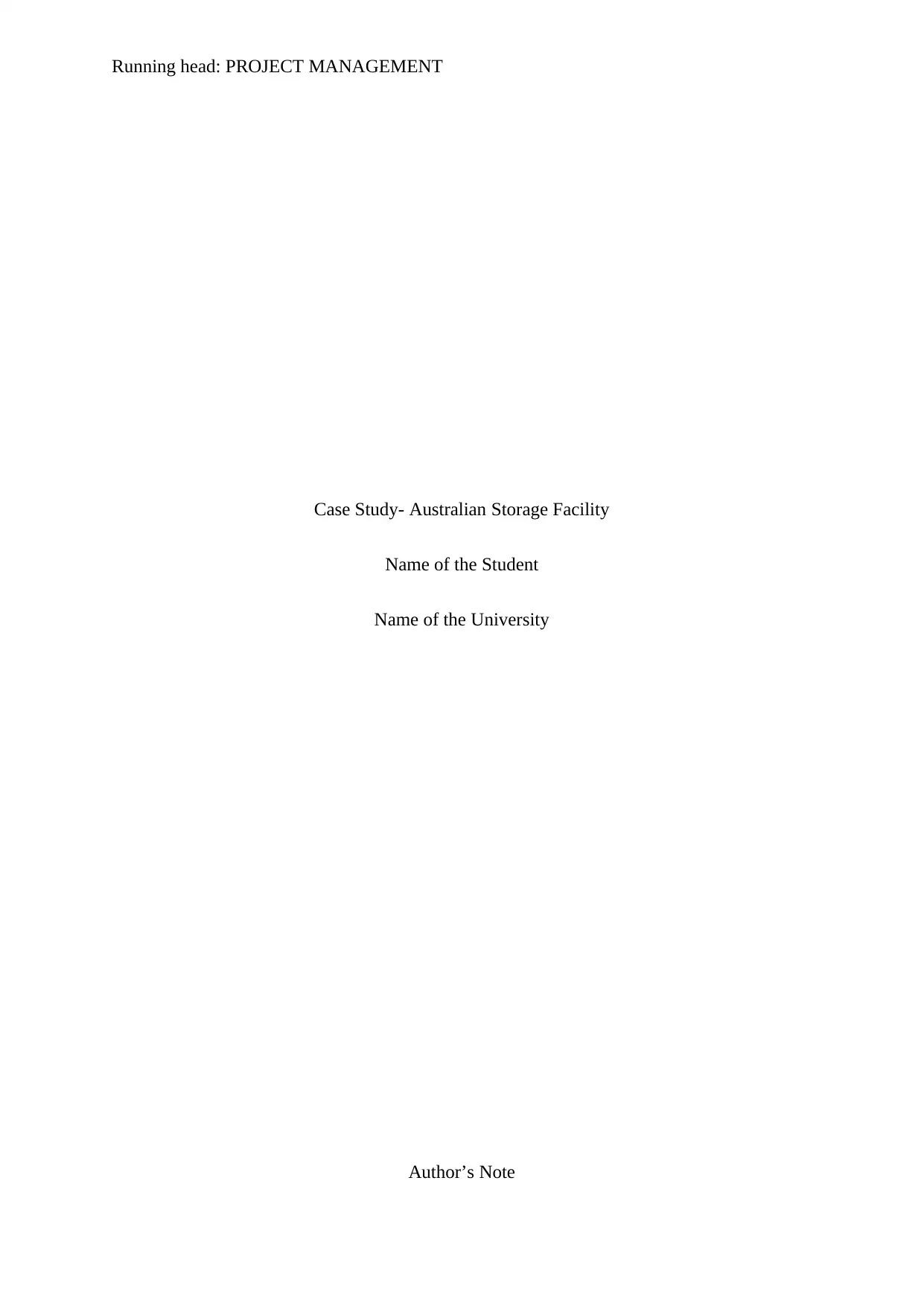
Running head: PROJECT MANAGEMENT
Case Study- Australian Storage Facility
Name of the Student
Name of the University
Author’s Note
Case Study- Australian Storage Facility
Name of the Student
Name of the University
Author’s Note
Paraphrase This Document
Need a fresh take? Get an instant paraphrase of this document with our AI Paraphraser
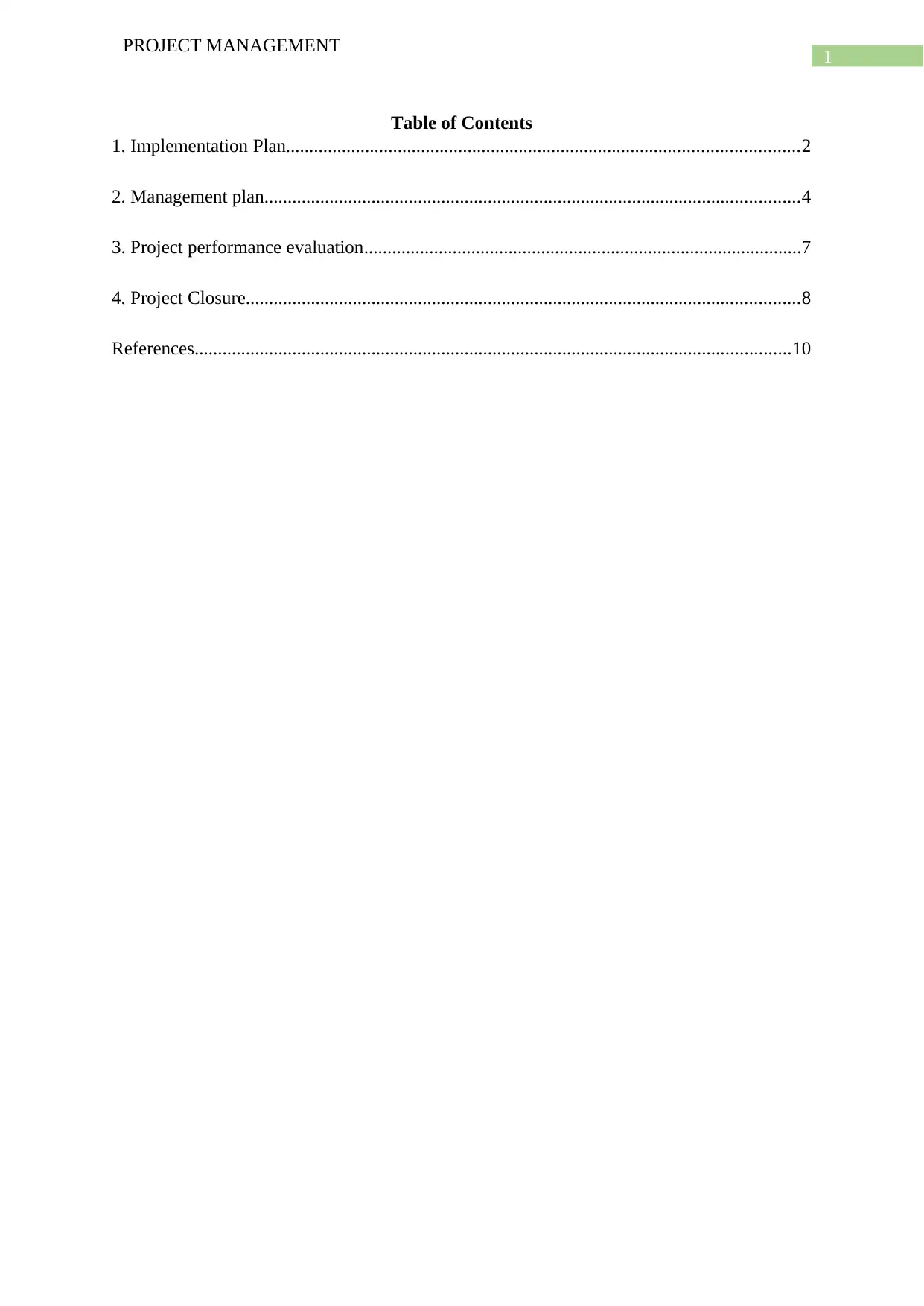
1
PROJECT MANAGEMENT
Table of Contents
1. Implementation Plan..............................................................................................................2
2. Management plan...................................................................................................................4
3. Project performance evaluation..............................................................................................7
4. Project Closure.......................................................................................................................8
References................................................................................................................................10
PROJECT MANAGEMENT
Table of Contents
1. Implementation Plan..............................................................................................................2
2. Management plan...................................................................................................................4
3. Project performance evaluation..............................................................................................7
4. Project Closure.......................................................................................................................8
References................................................................................................................................10
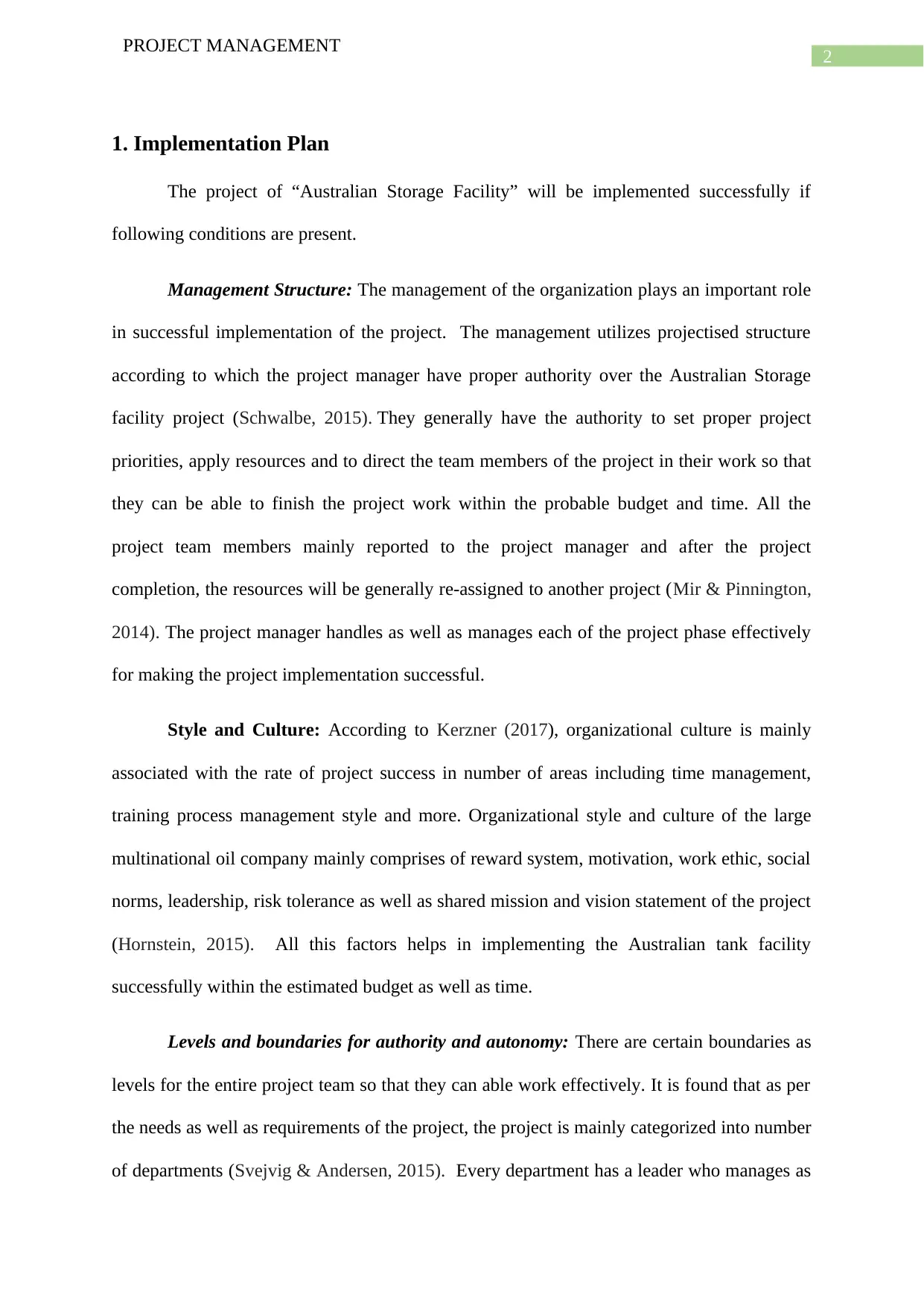
2
PROJECT MANAGEMENT
1. Implementation Plan
The project of “Australian Storage Facility” will be implemented successfully if
following conditions are present.
Management Structure: The management of the organization plays an important role
in successful implementation of the project. The management utilizes projectised structure
according to which the project manager have proper authority over the Australian Storage
facility project (Schwalbe, 2015). They generally have the authority to set proper project
priorities, apply resources and to direct the team members of the project in their work so that
they can be able to finish the project work within the probable budget and time. All the
project team members mainly reported to the project manager and after the project
completion, the resources will be generally re-assigned to another project (Mir & Pinnington,
2014). The project manager handles as well as manages each of the project phase effectively
for making the project implementation successful.
Style and Culture: According to Kerzner (2017), organizational culture is mainly
associated with the rate of project success in number of areas including time management,
training process management style and more. Organizational style and culture of the large
multinational oil company mainly comprises of reward system, motivation, work ethic, social
norms, leadership, risk tolerance as well as shared mission and vision statement of the project
(Hornstein, 2015). All this factors helps in implementing the Australian tank facility
successfully within the estimated budget as well as time.
Levels and boundaries for authority and autonomy: There are certain boundaries as
levels for the entire project team so that they can able work effectively. It is found that as per
the needs as well as requirements of the project, the project is mainly categorized into number
of departments (Svejvig & Andersen, 2015). Every department has a leader who manages as
PROJECT MANAGEMENT
1. Implementation Plan
The project of “Australian Storage Facility” will be implemented successfully if
following conditions are present.
Management Structure: The management of the organization plays an important role
in successful implementation of the project. The management utilizes projectised structure
according to which the project manager have proper authority over the Australian Storage
facility project (Schwalbe, 2015). They generally have the authority to set proper project
priorities, apply resources and to direct the team members of the project in their work so that
they can be able to finish the project work within the probable budget and time. All the
project team members mainly reported to the project manager and after the project
completion, the resources will be generally re-assigned to another project (Mir & Pinnington,
2014). The project manager handles as well as manages each of the project phase effectively
for making the project implementation successful.
Style and Culture: According to Kerzner (2017), organizational culture is mainly
associated with the rate of project success in number of areas including time management,
training process management style and more. Organizational style and culture of the large
multinational oil company mainly comprises of reward system, motivation, work ethic, social
norms, leadership, risk tolerance as well as shared mission and vision statement of the project
(Hornstein, 2015). All this factors helps in implementing the Australian tank facility
successfully within the estimated budget as well as time.
Levels and boundaries for authority and autonomy: There are certain boundaries as
levels for the entire project team so that they can able work effectively. It is found that as per
the needs as well as requirements of the project, the project is mainly categorized into number
of departments (Svejvig & Andersen, 2015). Every department has a leader who manages as
⊘ This is a preview!⊘
Do you want full access?
Subscribe today to unlock all pages.

Trusted by 1+ million students worldwide
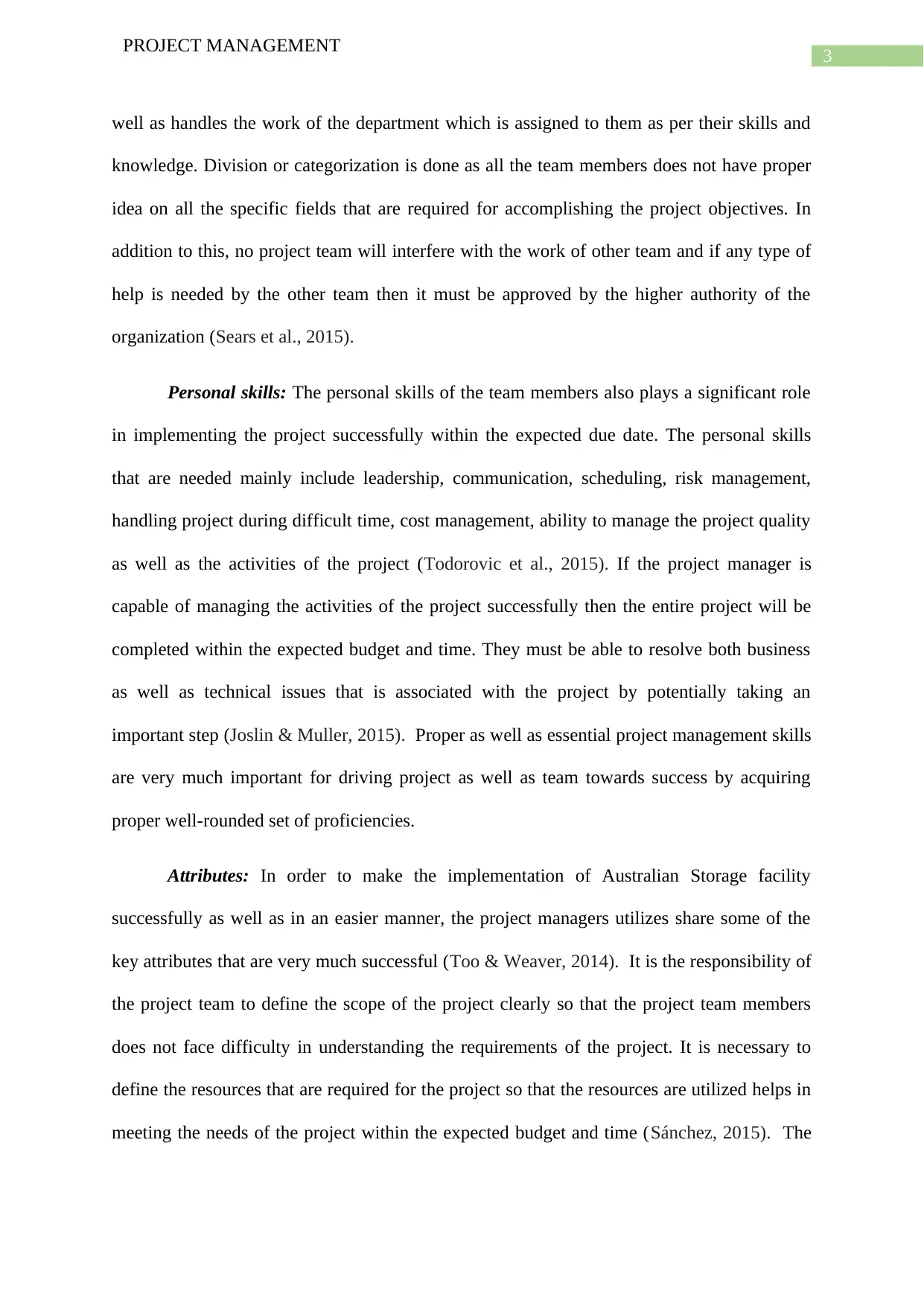
3
PROJECT MANAGEMENT
well as handles the work of the department which is assigned to them as per their skills and
knowledge. Division or categorization is done as all the team members does not have proper
idea on all the specific fields that are required for accomplishing the project objectives. In
addition to this, no project team will interfere with the work of other team and if any type of
help is needed by the other team then it must be approved by the higher authority of the
organization (Sears et al., 2015).
Personal skills: The personal skills of the team members also plays a significant role
in implementing the project successfully within the expected due date. The personal skills
that are needed mainly include leadership, communication, scheduling, risk management,
handling project during difficult time, cost management, ability to manage the project quality
as well as the activities of the project (Todorovic et al., 2015). If the project manager is
capable of managing the activities of the project successfully then the entire project will be
completed within the expected budget and time. They must be able to resolve both business
as well as technical issues that is associated with the project by potentially taking an
important step (Joslin & Muller, 2015). Proper as well as essential project management skills
are very much important for driving project as well as team towards success by acquiring
proper well-rounded set of proficiencies.
Attributes: In order to make the implementation of Australian Storage facility
successfully as well as in an easier manner, the project managers utilizes share some of the
key attributes that are very much successful (Too & Weaver, 2014). It is the responsibility of
the project team to define the scope of the project clearly so that the project team members
does not face difficulty in understanding the requirements of the project. It is necessary to
define the resources that are required for the project so that the resources are utilized helps in
meeting the needs of the project within the expected budget and time (Sánchez, 2015). The
PROJECT MANAGEMENT
well as handles the work of the department which is assigned to them as per their skills and
knowledge. Division or categorization is done as all the team members does not have proper
idea on all the specific fields that are required for accomplishing the project objectives. In
addition to this, no project team will interfere with the work of other team and if any type of
help is needed by the other team then it must be approved by the higher authority of the
organization (Sears et al., 2015).
Personal skills: The personal skills of the team members also plays a significant role
in implementing the project successfully within the expected due date. The personal skills
that are needed mainly include leadership, communication, scheduling, risk management,
handling project during difficult time, cost management, ability to manage the project quality
as well as the activities of the project (Todorovic et al., 2015). If the project manager is
capable of managing the activities of the project successfully then the entire project will be
completed within the expected budget and time. They must be able to resolve both business
as well as technical issues that is associated with the project by potentially taking an
important step (Joslin & Muller, 2015). Proper as well as essential project management skills
are very much important for driving project as well as team towards success by acquiring
proper well-rounded set of proficiencies.
Attributes: In order to make the implementation of Australian Storage facility
successfully as well as in an easier manner, the project managers utilizes share some of the
key attributes that are very much successful (Too & Weaver, 2014). It is the responsibility of
the project team to define the scope of the project clearly so that the project team members
does not face difficulty in understanding the requirements of the project. It is necessary to
define the resources that are required for the project so that the resources are utilized helps in
meeting the needs of the project within the expected budget and time (Sánchez, 2015). The
Paraphrase This Document
Need a fresh take? Get an instant paraphrase of this document with our AI Paraphraser
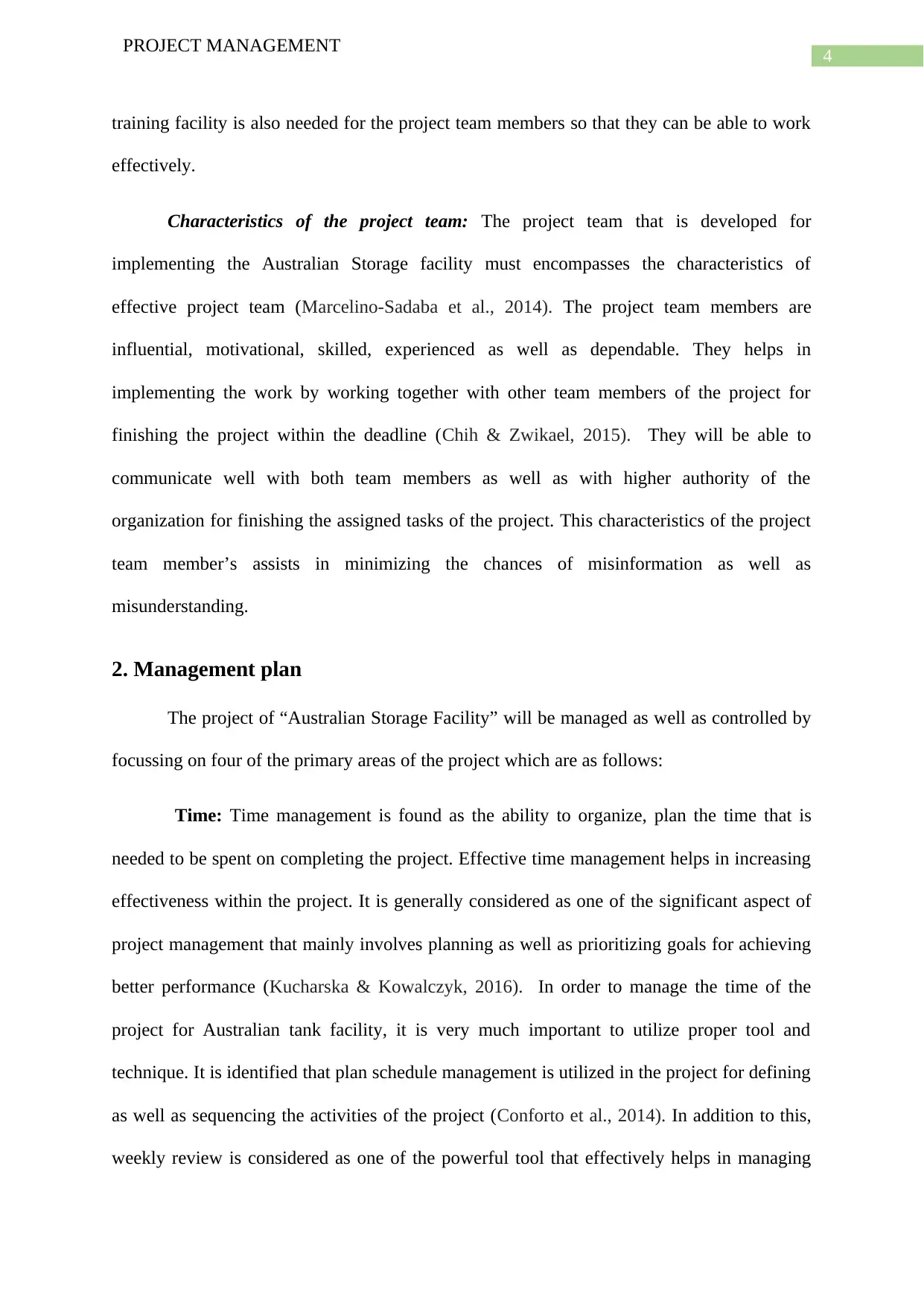
4
PROJECT MANAGEMENT
training facility is also needed for the project team members so that they can be able to work
effectively.
Characteristics of the project team: The project team that is developed for
implementing the Australian Storage facility must encompasses the characteristics of
effective project team (Marcelino-Sadaba et al., 2014). The project team members are
influential, motivational, skilled, experienced as well as dependable. They helps in
implementing the work by working together with other team members of the project for
finishing the project within the deadline (Chih & Zwikael, 2015). They will be able to
communicate well with both team members as well as with higher authority of the
organization for finishing the assigned tasks of the project. This characteristics of the project
team member’s assists in minimizing the chances of misinformation as well as
misunderstanding.
2. Management plan
The project of “Australian Storage Facility” will be managed as well as controlled by
focussing on four of the primary areas of the project which are as follows:
Time: Time management is found as the ability to organize, plan the time that is
needed to be spent on completing the project. Effective time management helps in increasing
effectiveness within the project. It is generally considered as one of the significant aspect of
project management that mainly involves planning as well as prioritizing goals for achieving
better performance (Kucharska & Kowalczyk, 2016). In order to manage the time of the
project for Australian tank facility, it is very much important to utilize proper tool and
technique. It is identified that plan schedule management is utilized in the project for defining
as well as sequencing the activities of the project (Conforto et al., 2014). In addition to this,
weekly review is considered as one of the powerful tool that effectively helps in managing
PROJECT MANAGEMENT
training facility is also needed for the project team members so that they can be able to work
effectively.
Characteristics of the project team: The project team that is developed for
implementing the Australian Storage facility must encompasses the characteristics of
effective project team (Marcelino-Sadaba et al., 2014). The project team members are
influential, motivational, skilled, experienced as well as dependable. They helps in
implementing the work by working together with other team members of the project for
finishing the project within the deadline (Chih & Zwikael, 2015). They will be able to
communicate well with both team members as well as with higher authority of the
organization for finishing the assigned tasks of the project. This characteristics of the project
team member’s assists in minimizing the chances of misinformation as well as
misunderstanding.
2. Management plan
The project of “Australian Storage Facility” will be managed as well as controlled by
focussing on four of the primary areas of the project which are as follows:
Time: Time management is found as the ability to organize, plan the time that is
needed to be spent on completing the project. Effective time management helps in increasing
effectiveness within the project. It is generally considered as one of the significant aspect of
project management that mainly involves planning as well as prioritizing goals for achieving
better performance (Kucharska & Kowalczyk, 2016). In order to manage the time of the
project for Australian tank facility, it is very much important to utilize proper tool and
technique. It is identified that plan schedule management is utilized in the project for defining
as well as sequencing the activities of the project (Conforto et al., 2014). In addition to this,
weekly review is considered as one of the powerful tool that effectively helps in managing
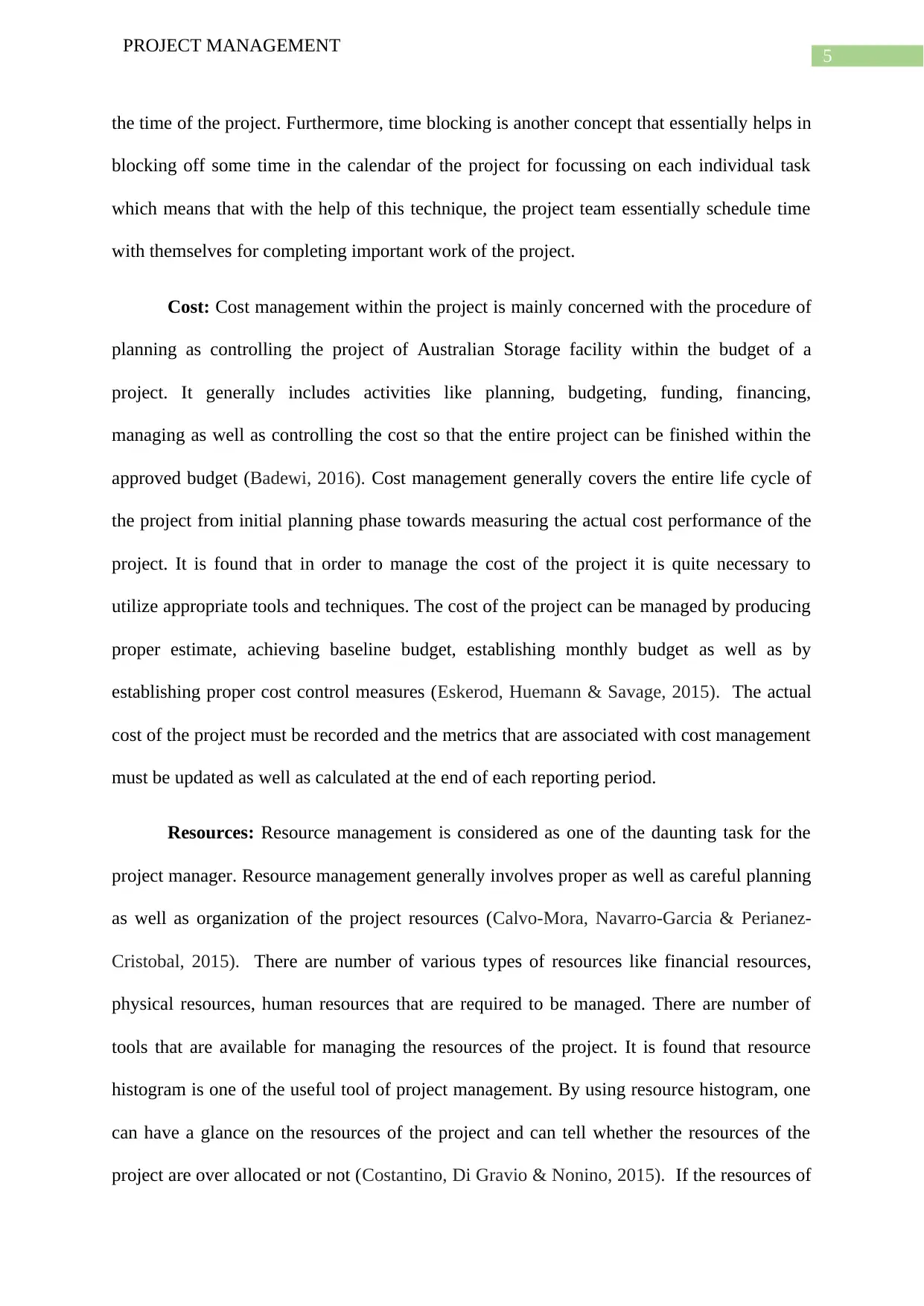
5
PROJECT MANAGEMENT
the time of the project. Furthermore, time blocking is another concept that essentially helps in
blocking off some time in the calendar of the project for focussing on each individual task
which means that with the help of this technique, the project team essentially schedule time
with themselves for completing important work of the project.
Cost: Cost management within the project is mainly concerned with the procedure of
planning as controlling the project of Australian Storage facility within the budget of a
project. It generally includes activities like planning, budgeting, funding, financing,
managing as well as controlling the cost so that the entire project can be finished within the
approved budget (Badewi, 2016). Cost management generally covers the entire life cycle of
the project from initial planning phase towards measuring the actual cost performance of the
project. It is found that in order to manage the cost of the project it is quite necessary to
utilize appropriate tools and techniques. The cost of the project can be managed by producing
proper estimate, achieving baseline budget, establishing monthly budget as well as by
establishing proper cost control measures (Eskerod, Huemann & Savage, 2015). The actual
cost of the project must be recorded and the metrics that are associated with cost management
must be updated as well as calculated at the end of each reporting period.
Resources: Resource management is considered as one of the daunting task for the
project manager. Resource management generally involves proper as well as careful planning
as well as organization of the project resources (Calvo-Mora, Navarro-Garcia & Perianez-
Cristobal, 2015). There are number of various types of resources like financial resources,
physical resources, human resources that are required to be managed. There are number of
tools that are available for managing the resources of the project. It is found that resource
histogram is one of the useful tool of project management. By using resource histogram, one
can have a glance on the resources of the project and can tell whether the resources of the
project are over allocated or not (Costantino, Di Gravio & Nonino, 2015). If the resources of
PROJECT MANAGEMENT
the time of the project. Furthermore, time blocking is another concept that essentially helps in
blocking off some time in the calendar of the project for focussing on each individual task
which means that with the help of this technique, the project team essentially schedule time
with themselves for completing important work of the project.
Cost: Cost management within the project is mainly concerned with the procedure of
planning as controlling the project of Australian Storage facility within the budget of a
project. It generally includes activities like planning, budgeting, funding, financing,
managing as well as controlling the cost so that the entire project can be finished within the
approved budget (Badewi, 2016). Cost management generally covers the entire life cycle of
the project from initial planning phase towards measuring the actual cost performance of the
project. It is found that in order to manage the cost of the project it is quite necessary to
utilize appropriate tools and techniques. The cost of the project can be managed by producing
proper estimate, achieving baseline budget, establishing monthly budget as well as by
establishing proper cost control measures (Eskerod, Huemann & Savage, 2015). The actual
cost of the project must be recorded and the metrics that are associated with cost management
must be updated as well as calculated at the end of each reporting period.
Resources: Resource management is considered as one of the daunting task for the
project manager. Resource management generally involves proper as well as careful planning
as well as organization of the project resources (Calvo-Mora, Navarro-Garcia & Perianez-
Cristobal, 2015). There are number of various types of resources like financial resources,
physical resources, human resources that are required to be managed. There are number of
tools that are available for managing the resources of the project. It is found that resource
histogram is one of the useful tool of project management. By using resource histogram, one
can have a glance on the resources of the project and can tell whether the resources of the
project are over allocated or not (Costantino, Di Gravio & Nonino, 2015). If the resources of
⊘ This is a preview!⊘
Do you want full access?
Subscribe today to unlock all pages.

Trusted by 1+ million students worldwide
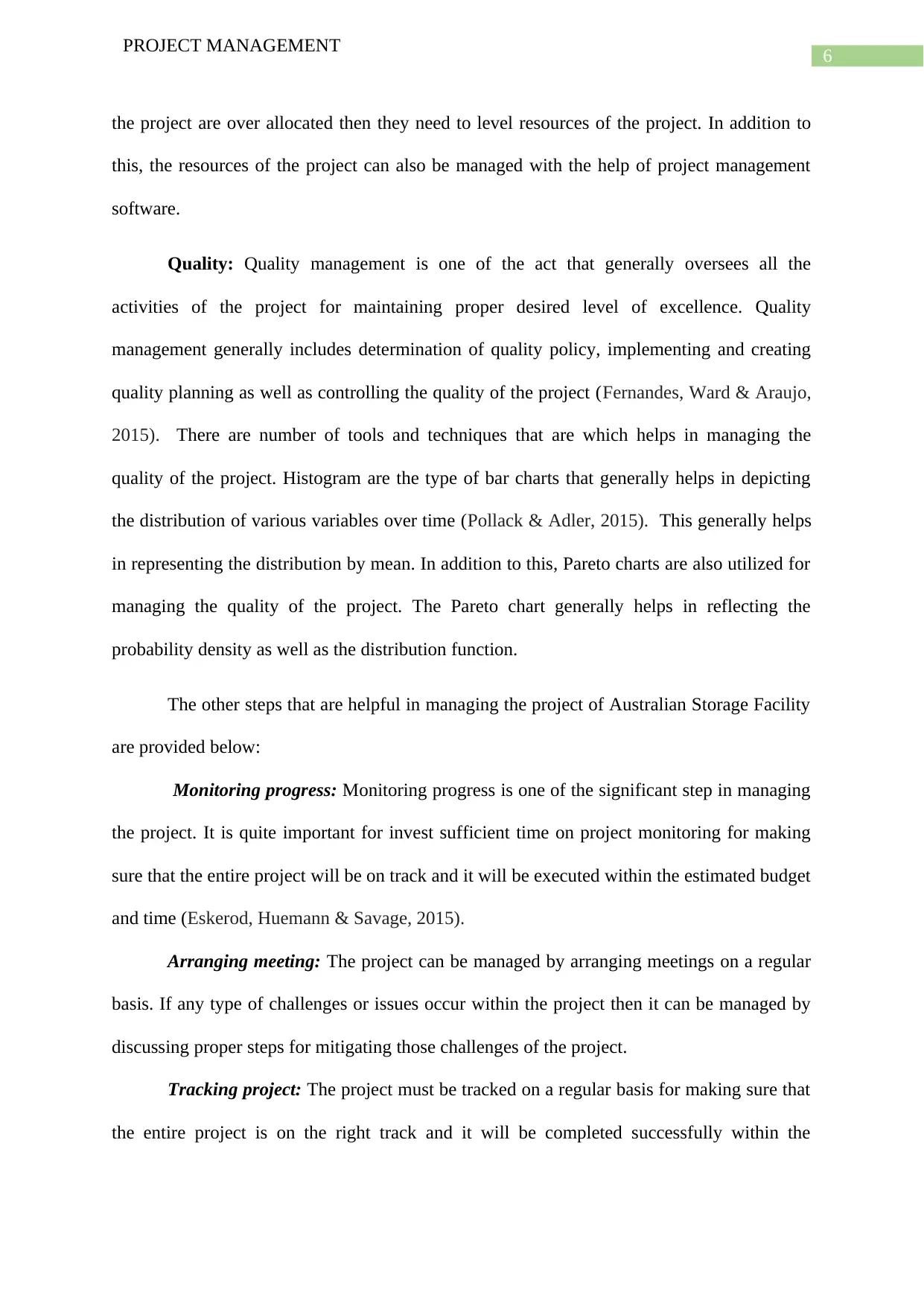
6
PROJECT MANAGEMENT
the project are over allocated then they need to level resources of the project. In addition to
this, the resources of the project can also be managed with the help of project management
software.
Quality: Quality management is one of the act that generally oversees all the
activities of the project for maintaining proper desired level of excellence. Quality
management generally includes determination of quality policy, implementing and creating
quality planning as well as controlling the quality of the project (Fernandes, Ward & Araujo,
2015). There are number of tools and techniques that are which helps in managing the
quality of the project. Histogram are the type of bar charts that generally helps in depicting
the distribution of various variables over time (Pollack & Adler, 2015). This generally helps
in representing the distribution by mean. In addition to this, Pareto charts are also utilized for
managing the quality of the project. The Pareto chart generally helps in reflecting the
probability density as well as the distribution function.
The other steps that are helpful in managing the project of Australian Storage Facility
are provided below:
Monitoring progress: Monitoring progress is one of the significant step in managing
the project. It is quite important for invest sufficient time on project monitoring for making
sure that the entire project will be on track and it will be executed within the estimated budget
and time (Eskerod, Huemann & Savage, 2015).
Arranging meeting: The project can be managed by arranging meetings on a regular
basis. If any type of challenges or issues occur within the project then it can be managed by
discussing proper steps for mitigating those challenges of the project.
Tracking project: The project must be tracked on a regular basis for making sure that
the entire project is on the right track and it will be completed successfully within the
PROJECT MANAGEMENT
the project are over allocated then they need to level resources of the project. In addition to
this, the resources of the project can also be managed with the help of project management
software.
Quality: Quality management is one of the act that generally oversees all the
activities of the project for maintaining proper desired level of excellence. Quality
management generally includes determination of quality policy, implementing and creating
quality planning as well as controlling the quality of the project (Fernandes, Ward & Araujo,
2015). There are number of tools and techniques that are which helps in managing the
quality of the project. Histogram are the type of bar charts that generally helps in depicting
the distribution of various variables over time (Pollack & Adler, 2015). This generally helps
in representing the distribution by mean. In addition to this, Pareto charts are also utilized for
managing the quality of the project. The Pareto chart generally helps in reflecting the
probability density as well as the distribution function.
The other steps that are helpful in managing the project of Australian Storage Facility
are provided below:
Monitoring progress: Monitoring progress is one of the significant step in managing
the project. It is quite important for invest sufficient time on project monitoring for making
sure that the entire project will be on track and it will be executed within the estimated budget
and time (Eskerod, Huemann & Savage, 2015).
Arranging meeting: The project can be managed by arranging meetings on a regular
basis. If any type of challenges or issues occur within the project then it can be managed by
discussing proper steps for mitigating those challenges of the project.
Tracking project: The project must be tracked on a regular basis for making sure that
the entire project is on the right track and it will be completed successfully within the
Paraphrase This Document
Need a fresh take? Get an instant paraphrase of this document with our AI Paraphraser
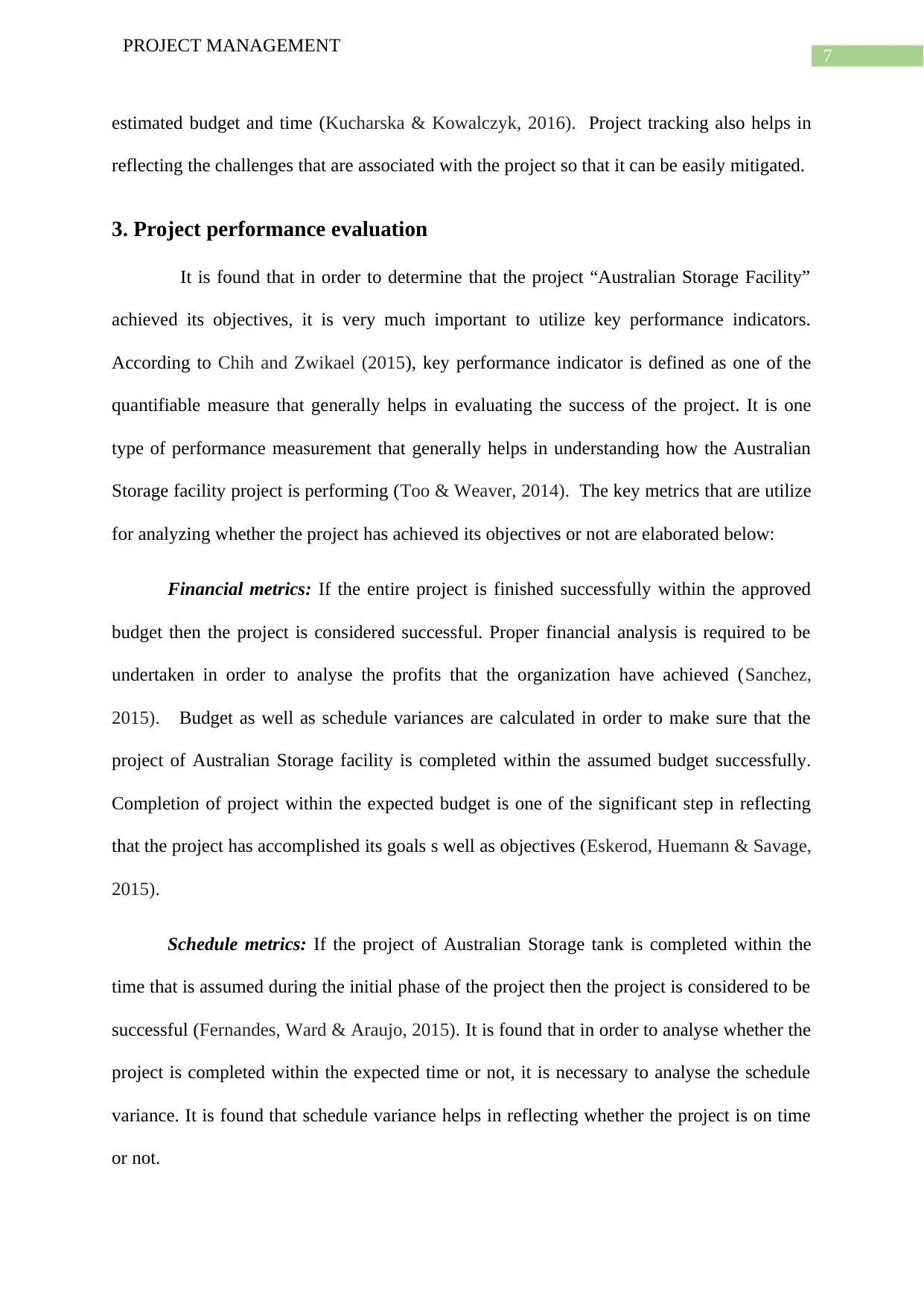
7
PROJECT MANAGEMENT
estimated budget and time (Kucharska & Kowalczyk, 2016). Project tracking also helps in
reflecting the challenges that are associated with the project so that it can be easily mitigated.
3. Project performance evaluation
It is found that in order to determine that the project “Australian Storage Facility”
achieved its objectives, it is very much important to utilize key performance indicators.
According to Chih and Zwikael (2015), key performance indicator is defined as one of the
quantifiable measure that generally helps in evaluating the success of the project. It is one
type of performance measurement that generally helps in understanding how the Australian
Storage facility project is performing (Too & Weaver, 2014). The key metrics that are utilize
for analyzing whether the project has achieved its objectives or not are elaborated below:
Financial metrics: If the entire project is finished successfully within the approved
budget then the project is considered successful. Proper financial analysis is required to be
undertaken in order to analyse the profits that the organization have achieved (Sanchez,
2015). Budget as well as schedule variances are calculated in order to make sure that the
project of Australian Storage facility is completed within the assumed budget successfully.
Completion of project within the expected budget is one of the significant step in reflecting
that the project has accomplished its goals s well as objectives (Eskerod, Huemann & Savage,
2015).
Schedule metrics: If the project of Australian Storage tank is completed within the
time that is assumed during the initial phase of the project then the project is considered to be
successful (Fernandes, Ward & Araujo, 2015). It is found that in order to analyse whether the
project is completed within the expected time or not, it is necessary to analyse the schedule
variance. It is found that schedule variance helps in reflecting whether the project is on time
or not.
PROJECT MANAGEMENT
estimated budget and time (Kucharska & Kowalczyk, 2016). Project tracking also helps in
reflecting the challenges that are associated with the project so that it can be easily mitigated.
3. Project performance evaluation
It is found that in order to determine that the project “Australian Storage Facility”
achieved its objectives, it is very much important to utilize key performance indicators.
According to Chih and Zwikael (2015), key performance indicator is defined as one of the
quantifiable measure that generally helps in evaluating the success of the project. It is one
type of performance measurement that generally helps in understanding how the Australian
Storage facility project is performing (Too & Weaver, 2014). The key metrics that are utilize
for analyzing whether the project has achieved its objectives or not are elaborated below:
Financial metrics: If the entire project is finished successfully within the approved
budget then the project is considered successful. Proper financial analysis is required to be
undertaken in order to analyse the profits that the organization have achieved (Sanchez,
2015). Budget as well as schedule variances are calculated in order to make sure that the
project of Australian Storage facility is completed within the assumed budget successfully.
Completion of project within the expected budget is one of the significant step in reflecting
that the project has accomplished its goals s well as objectives (Eskerod, Huemann & Savage,
2015).
Schedule metrics: If the project of Australian Storage tank is completed within the
time that is assumed during the initial phase of the project then the project is considered to be
successful (Fernandes, Ward & Araujo, 2015). It is found that in order to analyse whether the
project is completed within the expected time or not, it is necessary to analyse the schedule
variance. It is found that schedule variance helps in reflecting whether the project is on time
or not.
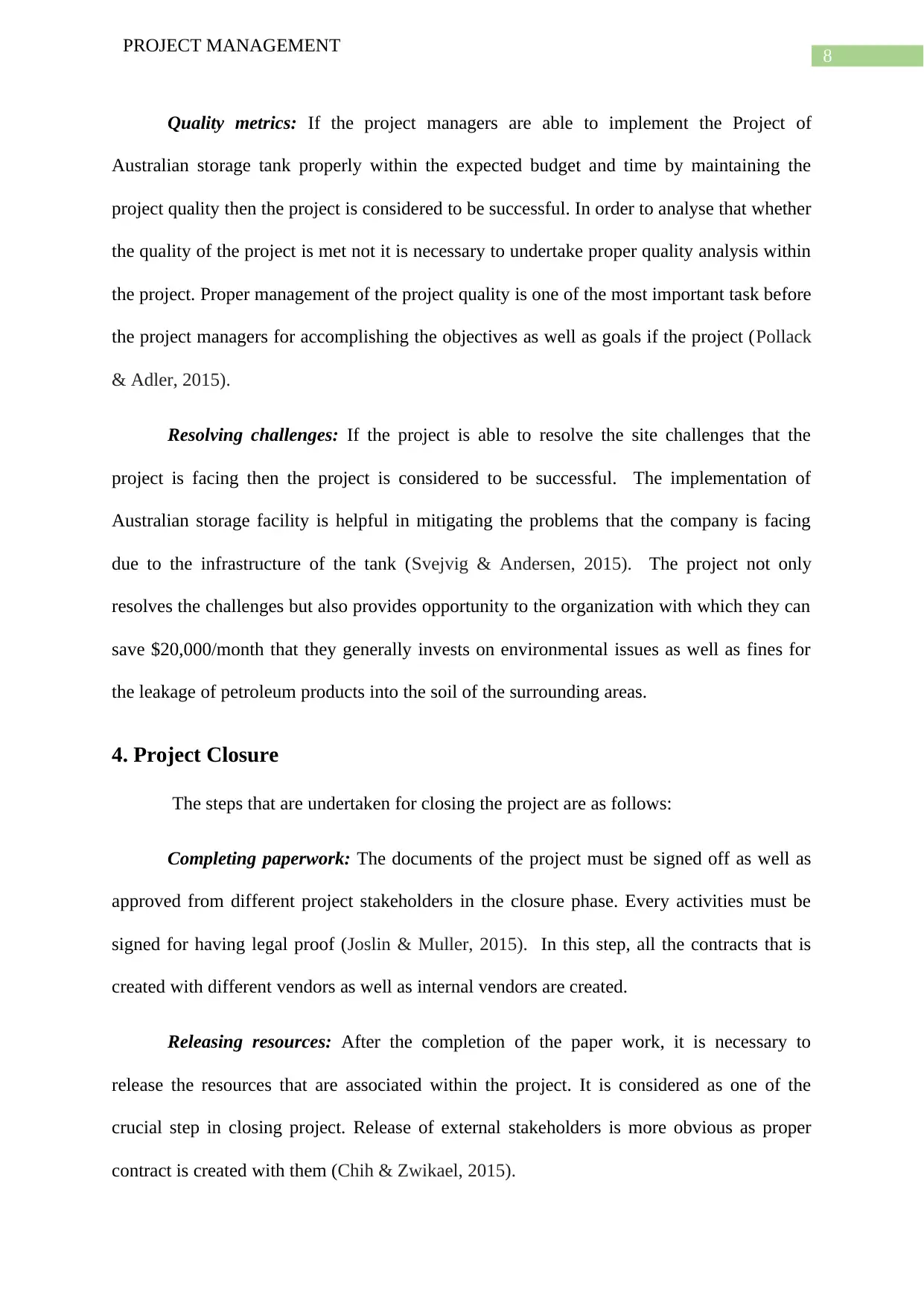
8
PROJECT MANAGEMENT
Quality metrics: If the project managers are able to implement the Project of
Australian storage tank properly within the expected budget and time by maintaining the
project quality then the project is considered to be successful. In order to analyse that whether
the quality of the project is met not it is necessary to undertake proper quality analysis within
the project. Proper management of the project quality is one of the most important task before
the project managers for accomplishing the objectives as well as goals if the project (Pollack
& Adler, 2015).
Resolving challenges: If the project is able to resolve the site challenges that the
project is facing then the project is considered to be successful. The implementation of
Australian storage facility is helpful in mitigating the problems that the company is facing
due to the infrastructure of the tank (Svejvig & Andersen, 2015). The project not only
resolves the challenges but also provides opportunity to the organization with which they can
save $20,000/month that they generally invests on environmental issues as well as fines for
the leakage of petroleum products into the soil of the surrounding areas.
4. Project Closure
The steps that are undertaken for closing the project are as follows:
Completing paperwork: The documents of the project must be signed off as well as
approved from different project stakeholders in the closure phase. Every activities must be
signed for having legal proof (Joslin & Muller, 2015). In this step, all the contracts that is
created with different vendors as well as internal vendors are created.
Releasing resources: After the completion of the paper work, it is necessary to
release the resources that are associated within the project. It is considered as one of the
crucial step in closing project. Release of external stakeholders is more obvious as proper
contract is created with them (Chih & Zwikael, 2015).
PROJECT MANAGEMENT
Quality metrics: If the project managers are able to implement the Project of
Australian storage tank properly within the expected budget and time by maintaining the
project quality then the project is considered to be successful. In order to analyse that whether
the quality of the project is met not it is necessary to undertake proper quality analysis within
the project. Proper management of the project quality is one of the most important task before
the project managers for accomplishing the objectives as well as goals if the project (Pollack
& Adler, 2015).
Resolving challenges: If the project is able to resolve the site challenges that the
project is facing then the project is considered to be successful. The implementation of
Australian storage facility is helpful in mitigating the problems that the company is facing
due to the infrastructure of the tank (Svejvig & Andersen, 2015). The project not only
resolves the challenges but also provides opportunity to the organization with which they can
save $20,000/month that they generally invests on environmental issues as well as fines for
the leakage of petroleum products into the soil of the surrounding areas.
4. Project Closure
The steps that are undertaken for closing the project are as follows:
Completing paperwork: The documents of the project must be signed off as well as
approved from different project stakeholders in the closure phase. Every activities must be
signed for having legal proof (Joslin & Muller, 2015). In this step, all the contracts that is
created with different vendors as well as internal vendors are created.
Releasing resources: After the completion of the paper work, it is necessary to
release the resources that are associated within the project. It is considered as one of the
crucial step in closing project. Release of external stakeholders is more obvious as proper
contract is created with them (Chih & Zwikael, 2015).
⊘ This is a preview!⊘
Do you want full access?
Subscribe today to unlock all pages.

Trusted by 1+ million students worldwide
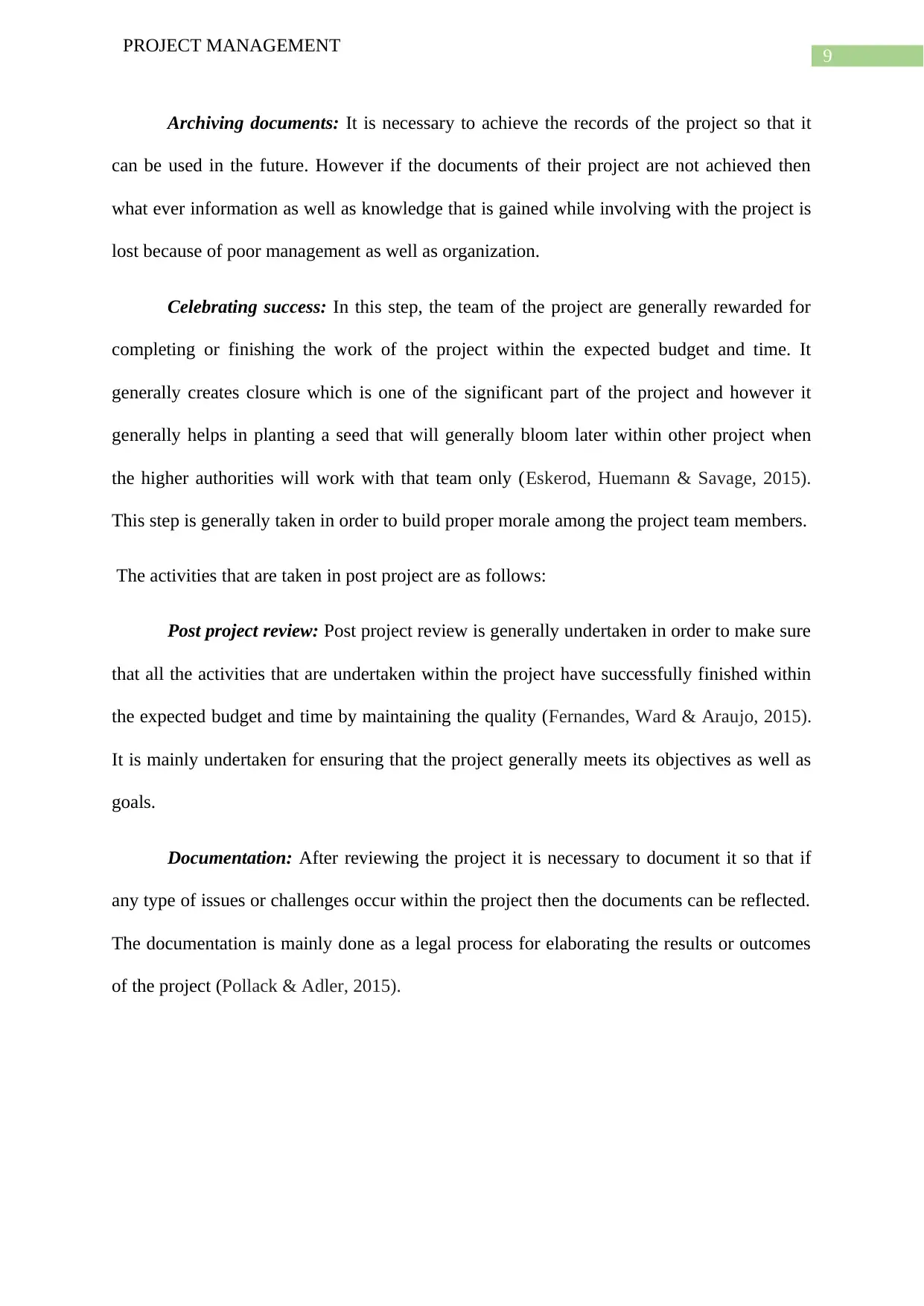
9
PROJECT MANAGEMENT
Archiving documents: It is necessary to achieve the records of the project so that it
can be used in the future. However if the documents of their project are not achieved then
what ever information as well as knowledge that is gained while involving with the project is
lost because of poor management as well as organization.
Celebrating success: In this step, the team of the project are generally rewarded for
completing or finishing the work of the project within the expected budget and time. It
generally creates closure which is one of the significant part of the project and however it
generally helps in planting a seed that will generally bloom later within other project when
the higher authorities will work with that team only (Eskerod, Huemann & Savage, 2015).
This step is generally taken in order to build proper morale among the project team members.
The activities that are taken in post project are as follows:
Post project review: Post project review is generally undertaken in order to make sure
that all the activities that are undertaken within the project have successfully finished within
the expected budget and time by maintaining the quality (Fernandes, Ward & Araujo, 2015).
It is mainly undertaken for ensuring that the project generally meets its objectives as well as
goals.
Documentation: After reviewing the project it is necessary to document it so that if
any type of issues or challenges occur within the project then the documents can be reflected.
The documentation is mainly done as a legal process for elaborating the results or outcomes
of the project (Pollack & Adler, 2015).
PROJECT MANAGEMENT
Archiving documents: It is necessary to achieve the records of the project so that it
can be used in the future. However if the documents of their project are not achieved then
what ever information as well as knowledge that is gained while involving with the project is
lost because of poor management as well as organization.
Celebrating success: In this step, the team of the project are generally rewarded for
completing or finishing the work of the project within the expected budget and time. It
generally creates closure which is one of the significant part of the project and however it
generally helps in planting a seed that will generally bloom later within other project when
the higher authorities will work with that team only (Eskerod, Huemann & Savage, 2015).
This step is generally taken in order to build proper morale among the project team members.
The activities that are taken in post project are as follows:
Post project review: Post project review is generally undertaken in order to make sure
that all the activities that are undertaken within the project have successfully finished within
the expected budget and time by maintaining the quality (Fernandes, Ward & Araujo, 2015).
It is mainly undertaken for ensuring that the project generally meets its objectives as well as
goals.
Documentation: After reviewing the project it is necessary to document it so that if
any type of issues or challenges occur within the project then the documents can be reflected.
The documentation is mainly done as a legal process for elaborating the results or outcomes
of the project (Pollack & Adler, 2015).
Paraphrase This Document
Need a fresh take? Get an instant paraphrase of this document with our AI Paraphraser
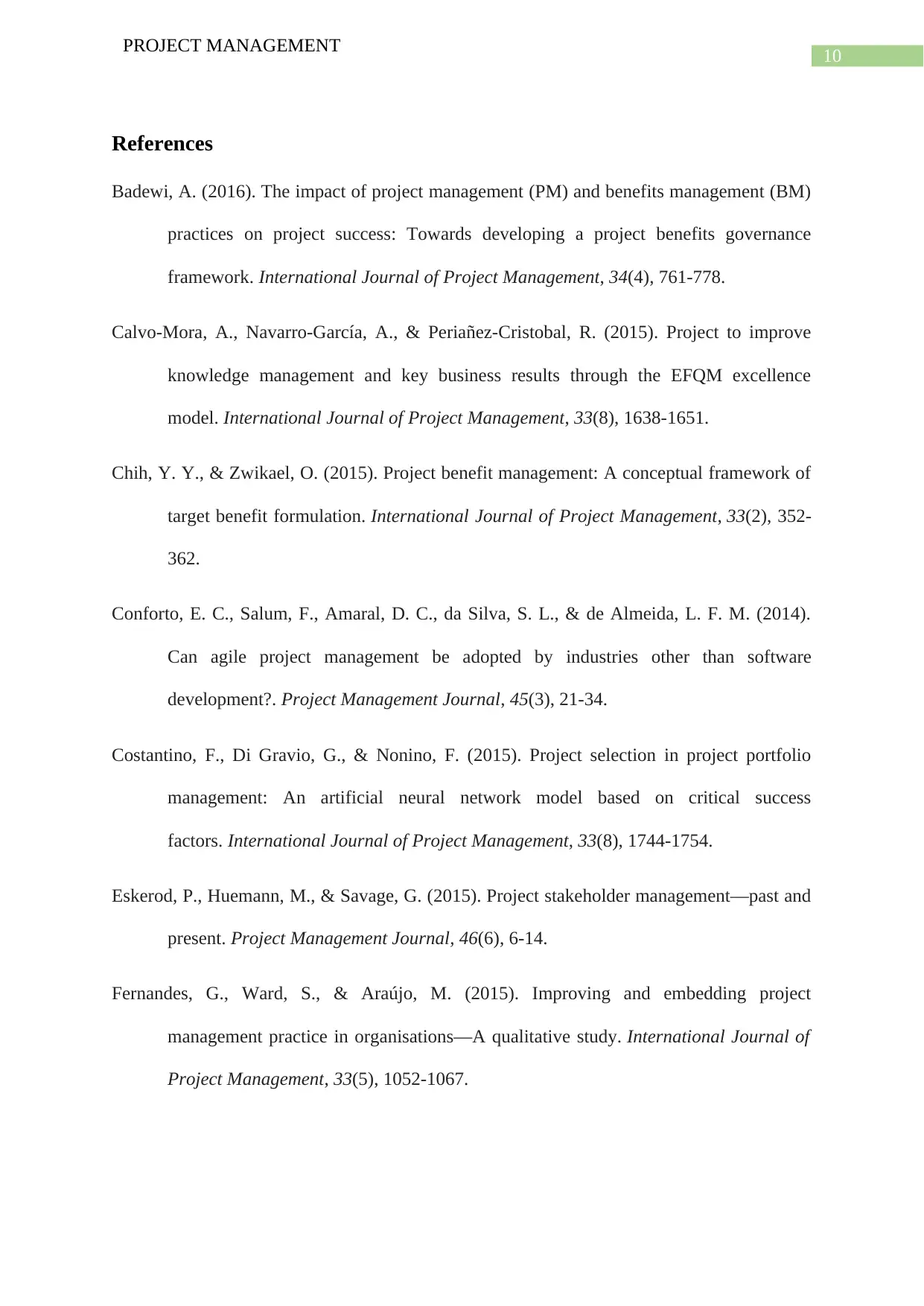
10
PROJECT MANAGEMENT
References
Badewi, A. (2016). The impact of project management (PM) and benefits management (BM)
practices on project success: Towards developing a project benefits governance
framework. International Journal of Project Management, 34(4), 761-778.
Calvo-Mora, A., Navarro-García, A., & Periañez-Cristobal, R. (2015). Project to improve
knowledge management and key business results through the EFQM excellence
model. International Journal of Project Management, 33(8), 1638-1651.
Chih, Y. Y., & Zwikael, O. (2015). Project benefit management: A conceptual framework of
target benefit formulation. International Journal of Project Management, 33(2), 352-
362.
Conforto, E. C., Salum, F., Amaral, D. C., da Silva, S. L., & de Almeida, L. F. M. (2014).
Can agile project management be adopted by industries other than software
development?. Project Management Journal, 45(3), 21-34.
Costantino, F., Di Gravio, G., & Nonino, F. (2015). Project selection in project portfolio
management: An artificial neural network model based on critical success
factors. International Journal of Project Management, 33(8), 1744-1754.
Eskerod, P., Huemann, M., & Savage, G. (2015). Project stakeholder management—past and
present. Project Management Journal, 46(6), 6-14.
Fernandes, G., Ward, S., & Araújo, M. (2015). Improving and embedding project
management practice in organisations—A qualitative study. International Journal of
Project Management, 33(5), 1052-1067.
PROJECT MANAGEMENT
References
Badewi, A. (2016). The impact of project management (PM) and benefits management (BM)
practices on project success: Towards developing a project benefits governance
framework. International Journal of Project Management, 34(4), 761-778.
Calvo-Mora, A., Navarro-García, A., & Periañez-Cristobal, R. (2015). Project to improve
knowledge management and key business results through the EFQM excellence
model. International Journal of Project Management, 33(8), 1638-1651.
Chih, Y. Y., & Zwikael, O. (2015). Project benefit management: A conceptual framework of
target benefit formulation. International Journal of Project Management, 33(2), 352-
362.
Conforto, E. C., Salum, F., Amaral, D. C., da Silva, S. L., & de Almeida, L. F. M. (2014).
Can agile project management be adopted by industries other than software
development?. Project Management Journal, 45(3), 21-34.
Costantino, F., Di Gravio, G., & Nonino, F. (2015). Project selection in project portfolio
management: An artificial neural network model based on critical success
factors. International Journal of Project Management, 33(8), 1744-1754.
Eskerod, P., Huemann, M., & Savage, G. (2015). Project stakeholder management—past and
present. Project Management Journal, 46(6), 6-14.
Fernandes, G., Ward, S., & Araújo, M. (2015). Improving and embedding project
management practice in organisations—A qualitative study. International Journal of
Project Management, 33(5), 1052-1067.
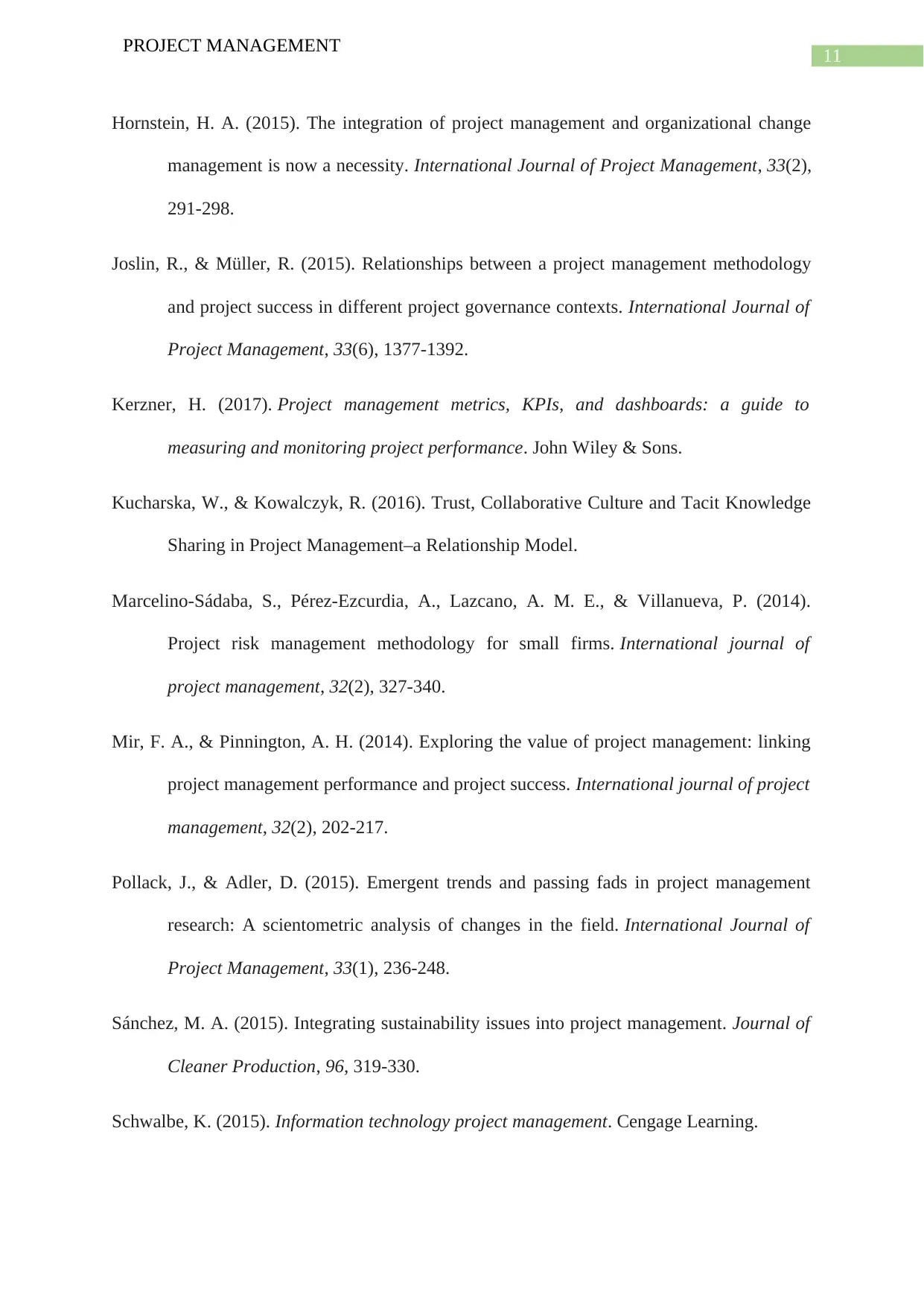
11
PROJECT MANAGEMENT
Hornstein, H. A. (2015). The integration of project management and organizational change
management is now a necessity. International Journal of Project Management, 33(2),
291-298.
Joslin, R., & Müller, R. (2015). Relationships between a project management methodology
and project success in different project governance contexts. International Journal of
Project Management, 33(6), 1377-1392.
Kerzner, H. (2017). Project management metrics, KPIs, and dashboards: a guide to
measuring and monitoring project performance. John Wiley & Sons.
Kucharska, W., & Kowalczyk, R. (2016). Trust, Collaborative Culture and Tacit Knowledge
Sharing in Project Management–a Relationship Model.
Marcelino-Sádaba, S., Pérez-Ezcurdia, A., Lazcano, A. M. E., & Villanueva, P. (2014).
Project risk management methodology for small firms. International journal of
project management, 32(2), 327-340.
Mir, F. A., & Pinnington, A. H. (2014). Exploring the value of project management: linking
project management performance and project success. International journal of project
management, 32(2), 202-217.
Pollack, J., & Adler, D. (2015). Emergent trends and passing fads in project management
research: A scientometric analysis of changes in the field. International Journal of
Project Management, 33(1), 236-248.
Sánchez, M. A. (2015). Integrating sustainability issues into project management. Journal of
Cleaner Production, 96, 319-330.
Schwalbe, K. (2015). Information technology project management. Cengage Learning.
PROJECT MANAGEMENT
Hornstein, H. A. (2015). The integration of project management and organizational change
management is now a necessity. International Journal of Project Management, 33(2),
291-298.
Joslin, R., & Müller, R. (2015). Relationships between a project management methodology
and project success in different project governance contexts. International Journal of
Project Management, 33(6), 1377-1392.
Kerzner, H. (2017). Project management metrics, KPIs, and dashboards: a guide to
measuring and monitoring project performance. John Wiley & Sons.
Kucharska, W., & Kowalczyk, R. (2016). Trust, Collaborative Culture and Tacit Knowledge
Sharing in Project Management–a Relationship Model.
Marcelino-Sádaba, S., Pérez-Ezcurdia, A., Lazcano, A. M. E., & Villanueva, P. (2014).
Project risk management methodology for small firms. International journal of
project management, 32(2), 327-340.
Mir, F. A., & Pinnington, A. H. (2014). Exploring the value of project management: linking
project management performance and project success. International journal of project
management, 32(2), 202-217.
Pollack, J., & Adler, D. (2015). Emergent trends and passing fads in project management
research: A scientometric analysis of changes in the field. International Journal of
Project Management, 33(1), 236-248.
Sánchez, M. A. (2015). Integrating sustainability issues into project management. Journal of
Cleaner Production, 96, 319-330.
Schwalbe, K. (2015). Information technology project management. Cengage Learning.
⊘ This is a preview!⊘
Do you want full access?
Subscribe today to unlock all pages.

Trusted by 1+ million students worldwide
1 out of 13
Related Documents
Your All-in-One AI-Powered Toolkit for Academic Success.
+13062052269
info@desklib.com
Available 24*7 on WhatsApp / Email
![[object Object]](/_next/static/media/star-bottom.7253800d.svg)
Unlock your academic potential
Copyright © 2020–2025 A2Z Services. All Rights Reserved. Developed and managed by ZUCOL.




